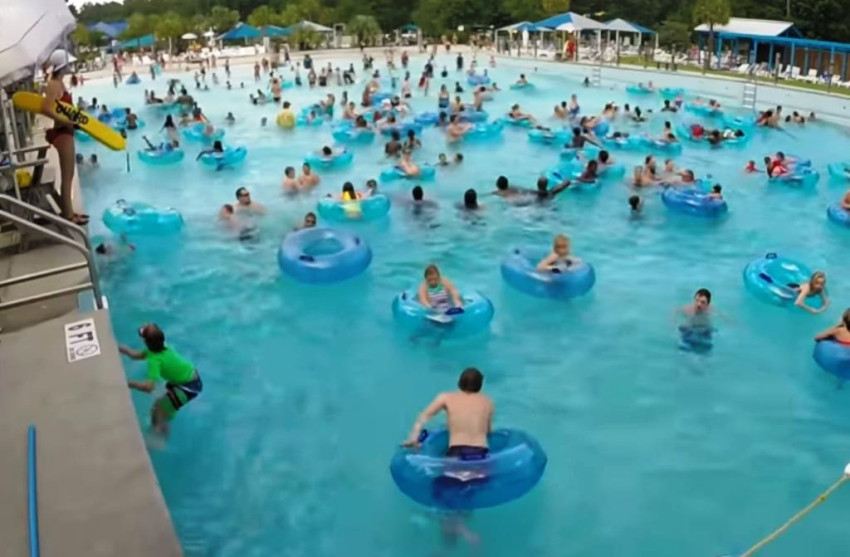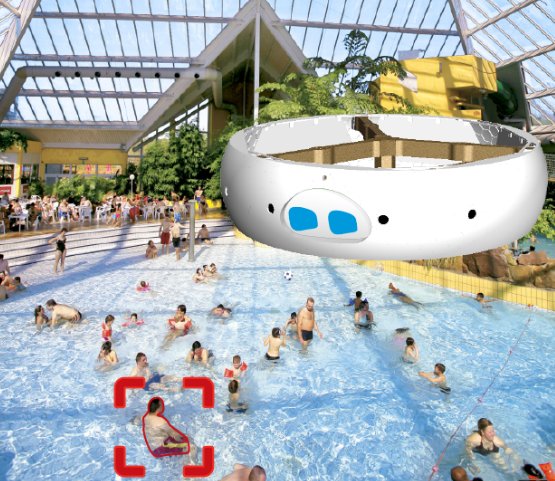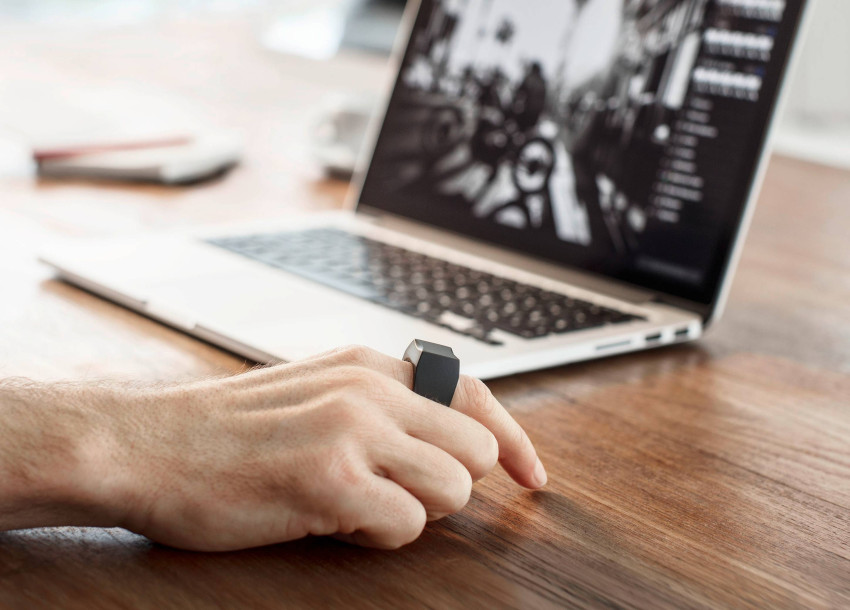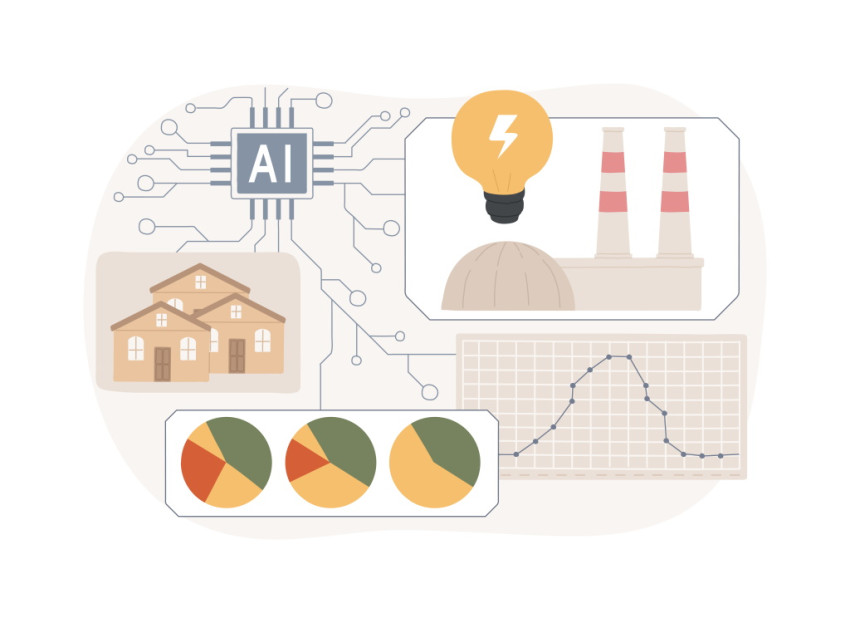
Drone saves child in swimming pool
This week students at Eindhoven University of Technology gave a demonstration of two drones that recognise a potential drowning incident and take the necessary action. The drones designed by the Blue Jay Eindhoven Team will give lifeguards the proverbial eyes in the back of the head.
It's in the news all too often: a child drowning in a swimming pool, sometimes even in the presence of hundreds of other swimmers and a couple of lifeguards.
All those people make it a tricky task for lifeguards to spot anyone struggling in the water. Why not try for yourself on the website Spotthedrowningchild.com. You'll soon see how it's nearly impossible to spot the child at risk of drowning, among all the fun-loving people.
Demonstration
The Team Blue Jay students developed a drone to solve this problem, which was demonstrated in the pool at the student sports centre in Eindhoven yesterday. This team, who have been together for three years, already produced a drone that can serve drinks, and an indoor drone for the healthcare sector.
The noise generated by the blades was found to be very loud for these indoor applications. 'A flying drone is noisy, after all. That's only acceptable in buildings with large open spaces or in certain emergency situations. At the time of a team brainstorming session, there had recently been a number of cases of drowning in the news. That gave us the idea for drone assistants in the swimming pool,' explains Mike van Sighem of the Blue Jay Team.

Source: Blue Jay Eindhoven.
Drone is airborne
The demonstration shows a possible future scenario. It's based on a swimming pool full of people. A child falls and hurts her knee, requiring the lifeguard to put a plaster on it, and temporarily look away from the pool. He therefore presses a button on his smartphone, and drone number one goes airborne to keep an eye on the swimmers from the air. If the drone detects a child struggling in the water, it immediately sends an alarm signal to the lifeguard. He or she takes to the water to save the child, while at the same time drone number two delivers a lifebuoy to the child in need.
Above water
There are already technical aids available for lifeguards. Cameras under the waterline of a pool check whether people are still moving, for example. The Blue Jay Team has taken a different approach, and uses cameras above water to automatically detect what people are doing: swimming or drowning.
The first step is executed by open-source Google Inception image recognition software that detects the location of people in an image (in three dimensions). Each person is then extracted by the software, and a mini video of 2 seconds, or 50 frames, is created per person. This is then fed into a machine-learning algorithm that is designed to recognise the status of the swimmer. Two possible situations have been defined: 'safe' or 'drowning'.
Well-trained
As is always the case with machine learning, the algorithm requires effective training, in this case by studying many moving images of people who are drowning. The team managed to find a unique solution for this pretty unusual requirement. 'A non-profit organisation in the US has voluntarily provided us with many images of drowning people. They generally use them in campaigns to raise awareness of the risk of drowning,' explains Van Sighem.
Lotus association
But that was not enough for the Blue Jay Team. In order to generate additional images to train their algorithm, the team requested the assistance of the Lotus Association volunteers who mimic accident and disaster victims during training exercises. This time, they spent a week in the swimming pool pretending to drown. This was all filmed from various angles, using ten cameras. 'We now have around 400 hours of useful video material with which we can train our algorithm.'
This has already reaped benefits, as the software (the algorithm) now identifies 97% of drowning persons. And in the case of persons who are safe, the algorithm correctly identified them in 80% of cases. There are therefore 20% false positives, cases in which the lifeguard's assistance would be requested, without actually being necessary. 'That may seem like a lot, but we chose that level on purpose,' says Van Sighem. Better safe than sorry.
Powerful computer
The machine-learning software requires a heavy-duty, expensive computer – a GPU server to be precise (a server with a number of powerful Graphics Processing Units, capable of advanced calculations). However, this is beyond the budget of the average swimming pool, and the team is therefore aiming to train the algorithm more effectively and render it lighter and simpler.
While the demonstration is undoubtedly spectacular, the drones of 2018 still require two people to operate them. Wouldn't that be even more expensive for the swimming pool? 'Our drones will indeed only offer added value once they can operate truly independently,' explains Van Sighem. They can already manoeuvre autonomously during the demo, but they're not yet good enough to function without supervision.
School swimming lessons
Another possibility is that the image recognition software could be useful in recognising possible drownings, without drones being necessary. A handful of fixed cameras, suspended at a great height for example, could already make swimming pools a great deal safer. The best option of all may be to reinstate school swimming lessons, so children learn to swim well at a young age.
If you found this article interesting, subscribe for free to our weekly newsletter!
Opening image: image from the video of a swimming pool security camera, showing how a lifeguard saves a swimmer, who appears to be drowning. Source: Spotthedrowningchild.com.






